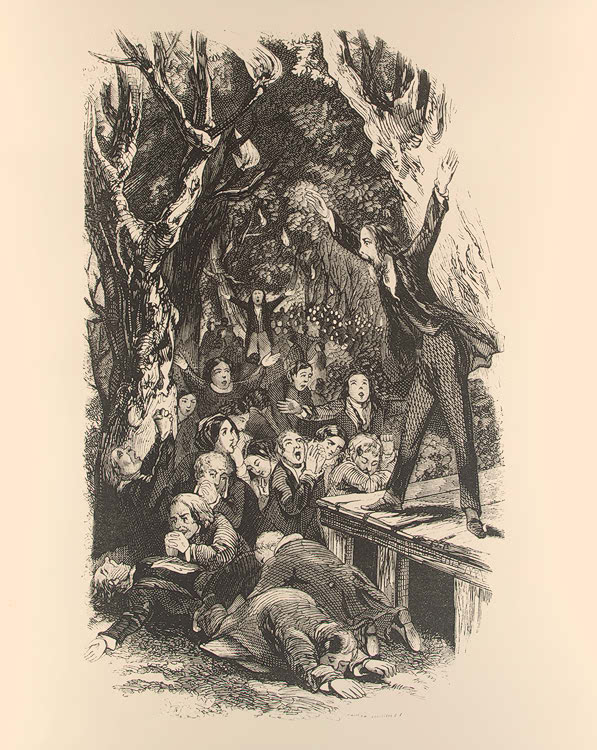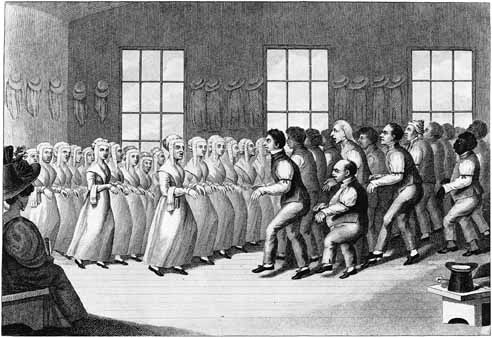Topic 5
Burgeoning Diversity, Competitive Denominationalism & the
Rising Evangelical Tide
|
|
OVERVIEW:
From the beginning of the Republic to the Civil War both the
nation and its religious life expanded remarkably. In those seventy
years American religion took on its distinctive characteristics: pluralistic,
individualistic, competitive,
expansionist.
As the implications of the Founders' revolutionary
ideas of religious liberty became clearer, Americans invented new ways
to make religious faith meaningful and relevant to national life. The
results, often dizzying, controversial and contradictory, shaped
American identity and character.
READING:
Marty
devotes almost three packed chapters to this period.
 |
He
organizes chapter 10, Into
the West and the World around the related themes of denominational
growth, westward
expansion and missionary
outreach to Asia and Africa. |
 |
Chapter
11, Beyond Existing Bounds, looks at new ways of being religious and of dissenting from existing religious
and social traditions. |
Because Marty's cast of characters and plot lines are so rich, his
readers can easily get lost. To avoid confusion as you use these
chapters and the online materials, keep in mind the basic question for this syllabus topic: What are the connections between the growth of the nation during the
first half of the 19th century on the one hand and the
burgeoning system of Competitive Denominationalism and the campaign for an Evangelical Empire on the other?
Porterfield:
"Shouting Methodists," an essay by Anne Taves, examines a form
of religious experience that was at the heart of evangelical revivalism.
What is the thesis or major point of the essay? How does she
develop that point? What does the essay reveal about how the Second
Awakening differed from the first Great Awakening of the 18th century?
Porterfield also has a document on Jerena Lee (#18). How, if
at all, does this source relate to the Taves essay? Choose two
passages from the source that highlight the source's significance
for understanding evangelical religion in the early republic.
Two other sources, Emerson
and Dickerson (#19 & 20), illustrate a very different current in
American cultural life, appealing to a different social class and marked
by the spirituality of the
Transcendental Movement
|
The religion of the
new American republic was evangelicalism, which, between 1800 and the Civil
War, was the "grand absorbing theme" of American religious life. During some
years in the first half of the nineteenth century, revivals (through which
evangelicalism found expression) occurred so often that religious publications
that specialized in tracking them lost count. In 1827, for example, one
journal exulted that "revivals, we rejoice to say, are becoming too numerous
in our country to admit of being generally mentioned in our Record." During
the years between the inaugurations of Thomas Jefferson and Abraham Lincoln,
historians see "evangelicalism emerging as a kind of national church or
national religion." The leaders and ordinary members of the "evangelical
empire" of the nineteenth century were American patriots who subscribed to the
views of the Founders that religion was a "necessary spring" for republican
government; they believed, as a preacher in 1826 asserted, that there was "an
association between Religion and Patriotism." Converting their fellow citizens
to Christianity was, for them, an act that simultaneously saved souls and
saved the republic. The American Home Missionary Society assured its
supporters in 1826 that "we are doing the work of patriotism no less than
Christianity." With the disappearance of efforts by government to create
morality in the body politic (symbolized by the termination in 1833 of
Massachusetts's tax support for churches) evangelical, benevolent societies
assumed that role, bringing about what today might be called the privatization
of the responsibility for forming a virtuous citizenry.
[Introduction to
Religion in the
New Republic, Library of Congress Exhibit.]
1.
Expanding
religion & the rise of evangelical Protestantism in the new Republic
Evangelicalism,
Revivalism, and the Second Great Awakening [overview by Donald Scott,
Queens College, in the Humanities Center's Divining America Series.]
THE CAMP MEETING
In 1800 major revivals that eventually reached into almost every
corner of the land began at opposite ends of the country: the decorous
Second Great Awakening in New England and the exuberant Great Revival in
Kentucky. The principal religious innovation produced by the Kentucky
revivals was the camp meeting. The revivals were organized by
Presbyterian ministers, who modeled them after the extended outdoor
"communion seasons," used by the Presbyterian Church in Scotland, which
frequently produced emotional, demonstrative displays of religious
conviction. In Kentucky the pioneers loaded their families and
provisions into their wagons and drove to the Presbyterian meetings,
where they pitched tents and settled in for several days. When assembled
in a field or at the edge of a forest for a prolonged religious meeting,
the participants transformed the site into a camp meeting. The religious
revivals that swept the Kentucky camp meetings were so intense and
created such gusts of emotion that their original sponsors, the
Presbyterians, as well the Baptists, soon repudiated them. The
Methodists, however, adopted and eventually domesticated camp meetings
and introduced them into the eastern United States, where for decades
they were one of the evangelical signatures of the denomination.
"Shouting Methodists," Discussion of essay
by Ann Taves in Porterfield.
Winthrop Hudson on Shouting Methodists
Jerking Exercise
Lorenzo Dow (1777-1834) was a spellbinding but eccentric traveling
Methodist evangelist who could still a turbulent camp meeting with
"the sound of his voice or at the sight of his fragile but
awe-inspiring presence." Dow's audiences often exhibited unusual
physical manifestations under the influence of his impassioned
preaching.

Charles Grandison Finney (1792-1875) also
Finney, What a
Revival of Religion Is
[in Porterfield
#17]
THE EMERGENCE OF THE AFRICAN
AMERICAN CHURCH
Scholars disagree about the extent of the native African content of
black Christianity as it emerged in eighteenth-century America, but
there is no dispute that the Christianity of the black population was
grounded in evangelicalism. The Second Great Awakening has been called
the "central and defining event in the development of
Afro-Christianity." During these revivals Baptists and Methodists
converted large numbers of blacks. However, many were disappointed at
the treatment they received from their fellow believers and at the
backsliding in the commitment to abolish slavery that many white
Baptists and Methodists had advocated immediately after the American
Revolution. When their discontent could not be contained, forceful black
leaders followed what was becoming an American habit--forming new
denominations. In 1787 Richard Allen (1760-1831) and his colleagues in
Philadelphia broke away from the Methodist Church and in 1815 founded
the African Methodist Episcopal (A. M. E.) Church, which, along with
independent black Baptist congregations, flourished as the century
progressed. By 1846, the A. M. E. Church, which began with 8 clergy and
5 churches, had grown to 176 clergy, 296 churches, and 17,375 members.
Religious Exuberance
Emotional exuberance was characteristic of evangelical religion in
both the white and black communities in the first half of the
nineteenth century.

Woman Preacher of the A.M.E. Church -
Another example of early 19th-century experimental religious life.
The black churches were graced by eloquent female preachers from
their earliest days, although there was, as in the white churches,
resistance in many quarters to the idea of women preaching the
Gospel.


2.
Democratic Diversity and New
Forms of Religion
The tradition of
religious freedom that characterized the early American republic
provided a hospitable environment for the development of new religious
institutions and experiences. The result was a mushrooming of new
churches, experimental worship and beliefs. For some observers this
diversity was proof of the creativity and value of democracy; for others
it was a sign of democratic excesses.
Mormons: Church of Jesus Christ of Latter Day Saints
The made-in-America new religion.
Another distinctive religious group, the Church of Jesus Christ of
Latter-day Saints or the Mormons, arose in the 1820s during the "Golden
Day of Democratic Evangelicalism." The founder, Joseph Smith
(1805-1844), and many of his earliest followers grew up in an area of
western New York called the "Burned Over District," because it had been
"scorched" by so many revivals. Smith had been "seared but not consumed"
by the exuberant evangelicalism of the era. However the Mormon Church
cannot be considered as the product of revivalism or as a splintering
off from an existing Protestant denomination. It was sui generis,
inspired by what Smith described as revelations on a series of gold
plates, which he translated and published as the Book of Mormon
in 1830. The new church conceived itself to be a restoration of
primitive Christianity, which other existing churches were considered to
have deserted. The Mormons subscribed to many orthodox Christian beliefs
but professed distinctive doctrines based on post-biblical revelation.
Persecuted from its inception, the Mormon Church moved from New York to
Ohio to Missouri to Illinois, where it put down strong roots at Nauvoo.
In 1844 the Nauvoo settlement was devastated by its neighbors, and Smith
and his brother were murdered. This attack prompted the Mormons, under
the leadership of Brigham Young, to migrate to Utah, where the first
parties arrived in July 1847. The church today is a flourishing,
worldwide denomination.
Excerpts from Smith's autobiographical recollections
Succinct
Essay on the Mormon Faith Tradition by J. Gordon Melton
Book of Mormon: An
Introduction
The Oneida Community
Battle Axe Letter
and Noyes' letter to Miss Holton
John Humphrey Noyes: Complex Marriage and Male Continence
Noyes and
the Oneida Perfectionists
The
Shakers
The Shakers, or the United Society of Believers in
Christ's Second Coming, were founded by "Mother Ann Lee, a
stalwart in the "Shaking Quakers" who migrated to America from
England in 1774. American Shakers shared with the Quakers a
devotion to simplicity in conduct and demeanor and to spiritual
equality. They "acquired their nickname from their practice of
whirling, trembling or shaking during religious services." The
Shakers used dancing as a worship practice. They often danced in
concentric circles and sometimes in the style shown here. Shaker
emissaries from New York visited Kentucky in the early years of
the nineteenth century to assess the revivals under way there
and made a modest number of converts.

Video documentary selections
The American
Shakers - a Boadside

Major American Denominations:
Difference between 1760s and 1850s.
Congregational, Presbyterian,
Anglican
Baptist, Methodist, Roman Catholic
|